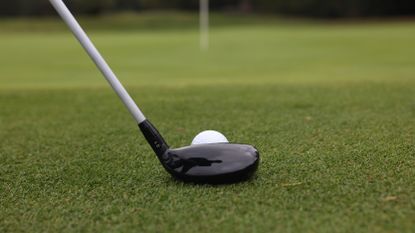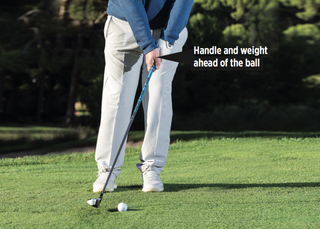How To Play The Hybrid Chip Shot
Boost your greenside skills by learning how to play the hybrid chip shot


Chipping strikes fear into many golfers, to the point that even the best wedges aren't enough to keep the demons at bay. Thankfully, there is another method, one that rose to prominence in tandem with the emergence of hybrid golf clubs. In the article below, PGA pro Alistair Davies presents his four-step guide on how to play the hybrid chip shot...
1. Assess the shot
Using a hybrid around the greens is a great skill to have, especially when you find yourself up against the fringe. You will find plenty of tour players using it when the lie is poor and they need to get the ball rolling onto the greens. What's more, it is such a safe shot - I'm amazed more amateurs don't use it. It's one of the many things tour players do that you don't.
In the case you have a lot of green to work with, the hybrid is a sensible option, even more so if you’ve been struggling with your wedges. The danger is coming over the fringe, which makes solid contact crucial.
2. Grip check

We’re looking to reduce forearm rotation through impact, so the perfect golf grip for this shot should have the club a little more in the palm of the hand so it runs more up the forearm.
This will also reduce unwanted wrist action and encourage you to hit the shot more like a putt. Keeping your wrists 'quiet' through the shot will also prevent you from creating too much speed - one of the key faults you need to be aware of!
3. Set-up basics
That solid contact I mention comes with the correct set-up. A narrow stance helps to get the ball rolling but be mindful of how far to stand from the golf ball. Quite often I see players standing too far away; this creates a more rounded arc to the swing, which means it’s harder to time the low point at impact.
Stand a bit closer than you would for a normal hybrid shot - the shaft will be more vertical at address. As for weight distribution, favour slightly more on the lead side.
Get the Golf Monthly Newsletter
Subscribe to the Golf Monthly newsletter to stay up to date with all the latest tour news, equipment news, reviews, head-to-heads and buyer’s guides from our team of experienced experts.
4. Angle of attack

A narrow stance also helps raise the centre of gravity slightly in the body to achieve a more downward angle of attack, which is important. You want to get the handle and weight ahead of the ball slightly through the strike to ensure you make ball-first contact.

A lifelong golf fan, Andy graduated in 2019 with a degree in Sports Journalism and got his first role in the industry as the Instruction Editor for National Club Golfer. From there, he decided to go freelance and now covers a variety of topics for Golf Monthly.
Andy took up the game at the age of seven and even harboured ambitions of a career in the professional ranks for a spell. That didn’t pan out, but he still enjoys his weekend golf at Royal Troon and holds a scratch handicap. As a side note, he's made five holes-in-one and could quite possibly be Retief Goosen’s biggest fan.
As well as the above, some of Andy's work has featured on websites such as goal.com, dailyrecord.co.uk, and theopen.com.
What's in Andy's bag?
Driver: Callaway Mavrik Sub-Zero (9°)
3-wood: TaylorMade Stealth 2 Plus (15°)
Driving iron: Titleist U500 (17°)
Irons: Mizuno mp32 (4-PW)
Wedges: Titleist Vokey SM9 (50°, 54° and 58°)
Putter: Titleist Scotty Cameron Newport 2.5
Ball: TaylorMade TP5x
-
 'Gator Netting Is In Place' - Chevron Championship Venue Prepared For 'Safe' Winner's Jump
'Gator Netting Is In Place' - Chevron Championship Venue Prepared For 'Safe' Winner's JumpA tradition which began at the tournament's previous home could continue this year - if the champion is feeling brave enough...
By Jonny Leighfield Published
-
 New Balance 997 SL Golf Shoe Review
New Balance 997 SL Golf Shoe ReviewNew Balance produce some extremely stylish footwear and, in this review, Matt Cradock takes their spikeless 997 SL onto the course
By Matt Cradock Published